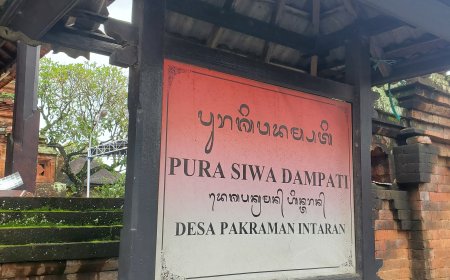Kehen Temple: A Silent Witness to History and Local Wisdom in Bangli
Bali is known as the Island of the Gods, rich in unparalleled culture and traditions, with temples scattered across the island. One such temple that holds great historical and spiritual significance is Kehen Temple, located in Bangli Regency. Majestically perched on a hill, Kehen Temple stands as a silent witness to the long journey of Balinese civilization and serves as a center of local wisdom that has been preserved to this day.

Kehen Temple, a Hindu temple located in Cempaga Village, Bangli District, Bangli Regency, Bali, Indonesia, has a rich history that can be traced through three copper inscriptions found in the temple area. The first inscription, estimated to date back to the Saka year 804-836 (882-914 AD), consists of 18 lines in Old Balinese and mentions the name "Hyang Karinama," which likely refers to Hyang Api, later evolving into Hyang Kehen in the third inscription. This indicates that Kehen Temple has existed since the 9th-10th centuries AD, with its name transitioning from Hyang Api to Hyang Kehen. The name "Kehen" comes from the Balinese word "awesome," meaning sacred fire.
The second inscription, dating from Saka 938-971 (1016-1049 AD), consists of 10 lines in Old Javanese, recording the names of royal officials and reflecting the temple's important role in governance during that time. The third inscription, dated to Saka 1126 (1204 AD), provides instructions for the residents on conducting major ceremonies at Kehen Temple. It also mentions King Sri Dhanadhiraja, son of King Bhatara Parameswara and grandson of Bhatara Guru Sri Adhikunti and his consort Bhatara Sri Dhanadewi, who ruled during that period.
Kehen Temple functions as a Pura Kahyangan Jagat, a sacred place for the local community to hold various religious ceremonies. Historically, the temple was also used as a place of oaths for royal officials who were unfaithful to their duties.

Ceremonies at Kehen Temple (Photo Source: Personal Collection)
As a spiritual center, Kehen Temple serves not only as a place of worship but also as a symbol of the local wisdom of the Balinese people, particularly in Bangli. Major ceremonies, such as Piodalan, are held every six months on Buda Keliwon Sinta, coinciding with the Pagerwesi holiday. During this five-day ceremony, all Banjar (local communities) from surrounding villages like Cempaga, Kawan, and Bebelang take turns offering their devotion through a procession known as Mepeed.
In addition, a ceremony held every three years during the fifth sasih (the fifth full moon) is called Karya Agung Bhatara Turun Kabeh. This grand ceremony typically lasts between 9 to 11 days. One of its key rituals is the Melasti procession, in which sacred statues (pratima) and holy objects are brought to the beach for purification. The ceremony involves thousands of people and various groups carrying gamelan (traditional musical instruments).

Bale Kulkul on The Trunk of a Banyan Tree (Photo Source: Personal Collection
Kehen Temple boasts many unique architectural features. One of its main distinctions is the entrance, which does not use a candi bentar (split gate) as typically seen in other Pura Kahyangan Jagat temples. Instead, Kehen Temple uses a candi kurung (enclosed gate), creating a unique and captivating impression. Another notable feature is the presence of a Bale Kulkul (wooden drum tower) integrated into the trunk of a large banyan tree, adding further character to the temple.
Kehen Temple is divided into three courtyards: the inner courtyard (jeroan), the middle courtyard (jaba tengah), and the outer courtyard (jaba sisi). Each courtyard is enclosed by walls with gates (gapura) allowing passage between them. The temple's structure is tiered, consisting of eight terraces. The first through fifth terraces make up the outer courtyard, the sixth terrace forms the first middle courtyard, the seventh terrace is the second middle courtyard, and the eighth terrace is the inner courtyard.

Praying at Kehen Temple (Photo Source: Personal Collection)
Kehen Temple is not only a silent witness to history but also a symbol of local wisdom in Bangli. With its unique architecture and special functions, Kehen Temple is also one of the most intriguing tourist attractions. Through the preserved copper inscriptions, we can trace how Kehen Temple has played an essential role in Balinese history and local culture.
Thus, Kehen Temple remains a sacred and valuable site for the local community, while also serving as a strong attraction for tourists seeking to explore the beauty and local wisdom of Bangli.




























































